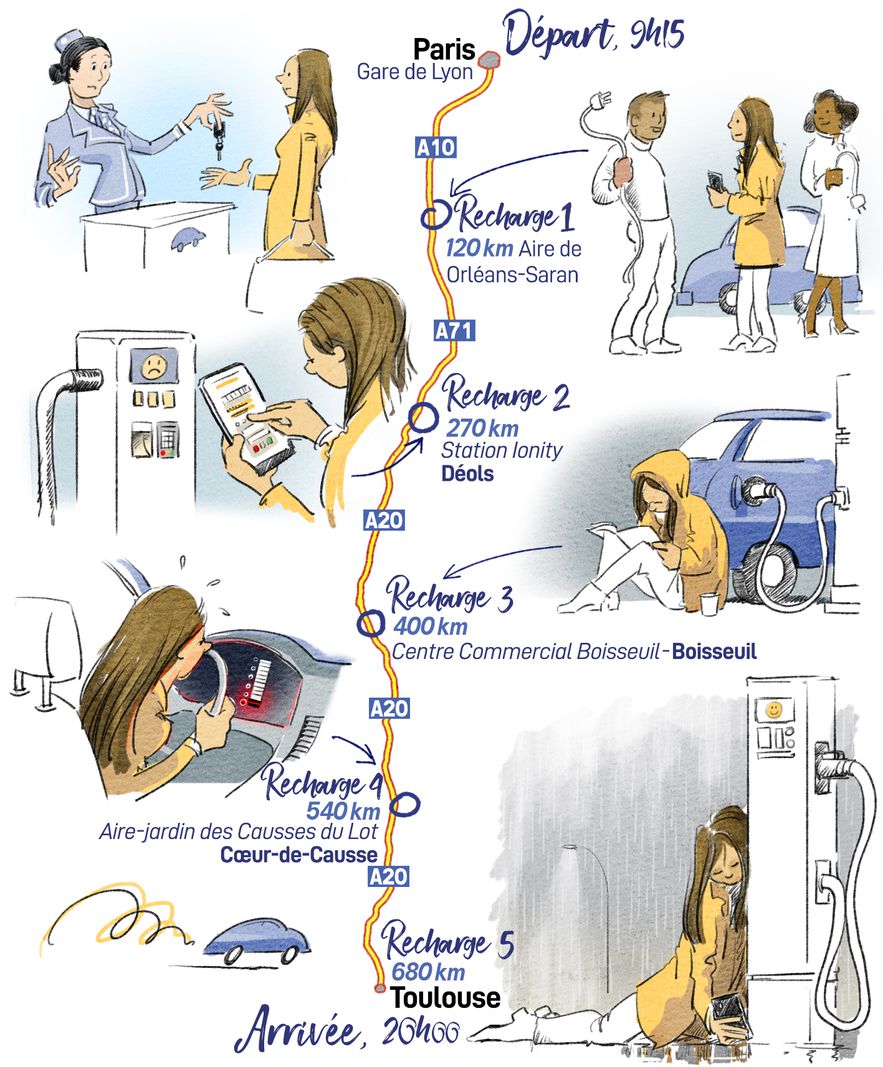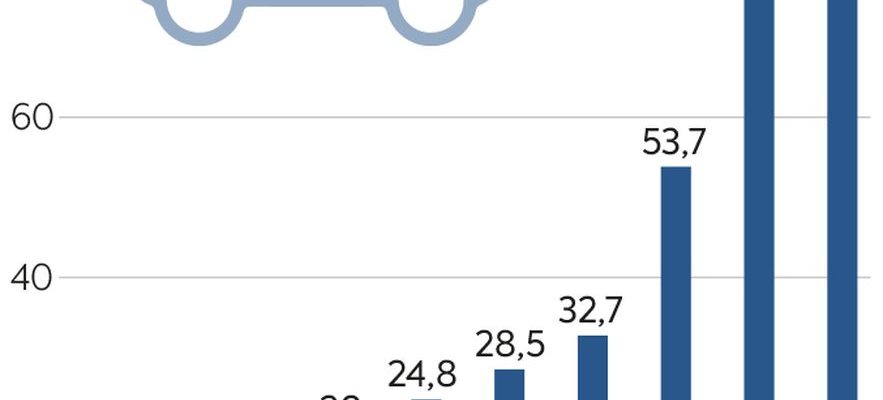In front of a handful of amused customers, the frank laughter of the hostess breaks the heavy silence of the underground car park of the Gare de Lyon, in Paris. While rummaging through the multitude of car keys at the rental agency, the young woman makes us repeat our destination several times. “An electric Paris-Toulouse? But what for? I don’t want to scare you, but frankly, you risk having a hard time.” After a quick check of the available vehicles, she hands us the keys to a small city car, whose autonomy is announced up to 320 kilometers, for a battery capacity of 42 kWh. Perhaps not the most suitable car for covering long distances in electric, but one of the best-selling models in France in 2022 – and one of the most affordable to rent. Above all, unlike the other vehicles of the agency, the racing car has the merit of being loaded at just over 80%.
According to a specialized application downloaded before the trip, it will take us about nine hours to cover the 680 kilometers that separate us from the Pink City, including 2h15 of recharging. “As soon as you drop below 30% battery, consider finding a charging solution. Otherwise, it’s like a toy!” Warns our interlocutor. Of which it would necessarily be necessary to change the batteries every 1h30, we can not help thinking while calculating our route. A slight anxiety is beginning to be felt: will the existing infrastructure and the autonomy of this city car really allow us to make the trip in a single day? To last longer, we turn off the heating, and we promise never to exceed the bar of 110 km/h.
But old habits die hard. Within half an hour, our promise is already a thing of the past, and the speedometer shows a speed of 130 km/h more often than expected. After only 120 kilometers of travel, the battery is down to less than 20%. Apprehension resurfaces: what would happen if, by misfortune, the charging stations announced by the application were not finally available at the next service station, near Orléans? Shameful call to the rental agency, desperate text message sent to our editor-in-chief, frantic search for a suitable outlet… While all the images of a disaster scenario go through our heads, the vision of a dozen terminals in perfect condition allays our doubts. “It’s a little disturbing the first few times,” admits Ludovic, seeing our look of relief once the cable is plugged in. The conversation with this forty-year-old, who calmly charges an electric car of the same model as ours, is quickly launched. We will often observe it during our trip: in the impersonal service stations, the “electrical conductors” often recognize each other, exchanging a few knowing glances.
“At the beginning, we don’t really know where to connect, how many kilometers we can do, how many stops it will require… And then we end up getting used to it. Above all, it’s better and better served!”, believes Ludovic. As of February 28, 2023, a barometer carried out by the Ministry of Ecological Transition and the association of electric mobility professionals Avere-France thus identified 90,803 charging points open to the public in the territory – compared to 55,515 in the same period in 2022, an increase of 63 % over twelve months. An impressive progression, which nevertheless does not reach the announced objective of 100,000 terminals available by the end of 2021, announced by Emmanuel Macron in May 2020.
© / Art Press
“There she is, the real hassle”
Orleans behind us, the miles are linked. But after a morning’s drive, hunger begins to set in. The signs announcing the presence of several stage villages make us eye. Why not stop there to avoid lunching an overpriced triangle sandwich at a motorway rest area? A quick check of the battery level answers the question: in many of them, electrical terminals have been installed, but we did not check their availability beforehand. The risk is too great. The break will take place in a fast-food restaurant near Châteauroux… Less charming. In the parking lot of this commercial area, Armand hides his smile when he sees us cursing at our smartphone. “I’ve always said it: for me, when you buy an electric car, you need training to learn how to use the terminals,” says the driver, who has been driving electric for five years. Because while some charging badges allow easy access to the various terminals, none yet offers the possibility of connecting to all the operators dispatched on the territory. In a rental car, we do not have such a sesame anyway: at each installation, you will have to connect to a specific application or scan a QR code on your phone, enter the number of the terminal, create an account with our personal information, enter the code of our credit card then validate the payment from our bank account… It is better to have patience. Especially since on the A20, time is starting to get long.

© / Stephane Humbert-Basset
After a third stop/recharge of half an hour in a shopping center car park near Limoges, then a new section of 145 kilometers traveled, the car battery shows (again) a very low charge level. It will be necessary to stop a fourth time to recharge the small city car. Too bad: gas station coffees have ended up disgusting us, and the radio hasn’t motivated us for a long time. About forty minutes later, we are off again, battery full, determined to reach our destination before dark. The wind is blowing. Heating on, we drive fast. Maybe a little too much. Arriving on the outskirts of Toulouse around 7 p.m., the battery shows a low 15%, for a range of around 30 kilometers. “Perfect”, we say to ourselves. The car will charge during our well-deserved night’s sleep.
But at the time of returning to the city, the dreaded unexpected event occurs. The exit indicated by the GPS is temporarily closed due to an accident. Eyes riveted on the crowded highway, we rely on our smartphone to recalculate the correct route by itself. Big mistake: twice, the latter makes us go through the closed exit, lengthening the journey by several kilometers. Finally arriving in front of our hotel, the battery shows 7%. Our energy level is roughly similar, and we will never be able to operate the urban terminal identified upstream on the application. On the dashboard, an error message is displayed on each attempt. Is the cable defective, the terminal faulty, or is fatigue playing tricks on us? We decide not to linger. Unexpected #2.
“Here it is, the real hassle”, we say to ourselves while driving at night, in this city that we do not know. The time to pass by a petrol station devoid of electric charging, then in front of a second terminal, this time clearly out of service, the battery level is so low that the dashboard no longer even displays its percentage. One last time, we rely on the application to find us, fissa, an available terminal. The GPS directs us to that of the car park of a restaurant, located less than two kilometers away. In front of the establishment, a man stands in front of the only installation, cable in hand. “Are you leaving or are you arriving?”, we ask him feverishly. “I’m leaving. It’s super fast, you’ll see! Take the time to make yourself a little restaurant while waiting.” Unwavering community spirit. For the fifth time today, QR code, customer account, bank card, half-hour wait. Plenty of time to do the accounts: the trip will have cost us a little more than 96 euros in electric refills, and will have lasted 10h45, including 2h45 of stops. Relieved, we enter the small restaurant to regain some strength. But tomorrow, we will have to hit the road again.
